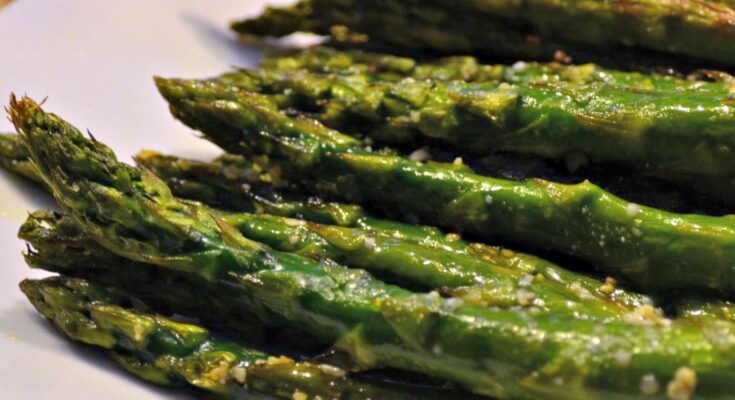Asparagus Recipe: Asparagus is one of those vegetables that feels fancy yet is easy to make! Whether you’re preparing a quick weekday meal or hosting a dinner party, asparagus always impresses.
Plus, it’s not just tasty; it’s packed with vitamins, fiber, and antioxidants. Its versatility makes it a go-to ingredient for roasting, sautéing, or steaming.
Ready to cook perfect asparagus every time? Let’s dive into the step-by-step guide!
Ingredients You’ll Need
- 1 pound of fresh asparagus
- 2 tablespoons olive oil or 1 tablespoon butter
- 1 teaspoon salt
- 1/2 teaspoon black pepper
- Optional: Garlic powder, lemon zest, Parmesan cheese, or balsamic glaze
Tools Required for the Recipe
- Sharp knife and cutting board
- Baking sheet (for roasting)
- Skillet (for sautéing)
- Tongs or spatula
- Aluminum foil or parchment paper
Step-by-Step Instructions to Make the Perfect Asparagus
Step 1 – Selecting Fresh Asparagus
When shopping for asparagus, look for stalks that are firm and bright green. The tips should be tightly closed, almost like little buds. Avoid stalks that are limp or have wrinkled ends—those are signs they’re past their prime. Thinner asparagus stalks tend to be more tender, while thicker ones have a meatier bite.
Step 2 – Prepping the Asparagus
Start by washing the asparagus under cold water to remove any dirt. Then, trim the woody ends—these can be tough and chewy. A neat trick is to gently bend the stalks near the bottom; they’ll naturally snap at the right point where the tender part starts.
Step 3 – Seasoning Options
For simple seasoning, toss the asparagus with olive oil, salt, and pepper. If you want to get creative, add garlic powder, chili flakes, or herbs. Love cheese? A sprinkle of Parmesan right before serving adds richness.
Different Ways to Cook Asparagus
Roasted Asparagus
Roasting brings out a nutty flavor in asparagus.
- Preheat the oven to 400°F (200°C).
- Spread the asparagus on a baking sheet, drizzle with olive oil, and season.
- Roast for 12-15 minutes until tender with slightly browned tips.
Sauteed Asparagus
Sauteing asparagus gives it a crisp-tender texture.
- Heat a tablespoon of butter or oil in a skillet over medium heat.
- Add the asparagus and cook for 5-7 minutes, tossing occasionally.
- Optional: Add minced garlic during the last minute of cooking for extra flavor.
Steamed Asparagus
Steaming is the healthiest way to cook asparagus without losing its nutrients.
- Bring a small amount of water to a boil in a pan with a steaming basket.
- Place the asparagus in the basket and steam for 4-5 minutes until tender.
- Serve immediately with a squeeze of lemon.
How to Know When Asparagus Is Done
Perfectly cooked asparagus will turn bright green and have a slight crunch. If it becomes too soft or mushy, it’s overcooked. The goal is to achieve a texture that’s tender but still holds its shape.
Variations and Flavor Combinations
- Garlic Butter and Parmesan: Toss with melted garlic butter and top with Parmesan.
- Lemon and Black Pepper: Squeeze fresh lemon juice over the asparagus and add cracked pepper.
- Balsamic Glaze and Nuts: Drizzle with balsamic glaze and sprinkle toasted almonds or pine nuts on top.
How to Serve Asparagus
Asparagus is a versatile side dish that pairs well with grilled chicken, salmon, or steak. You can also chop it and add it to pasta dishes or salads for extra flavor and texture.
Storing and Reheating Leftover Asparagus
Store cooked asparagus in an airtight container in the refrigerator for up to 3 days. To reheat, use a skillet over medium heat for a couple of minutes. Avoid the microwave—it can make the asparagus soggy.
Common Mistakes to Avoid When Cooking Asparagus
- Overcooking: This makes asparagus mushy and dull in color.
- Skipping the drying step: Wet asparagus won’t roast properly.
- Under-seasoning: Simple seasoning makes all the difference.
Nutritional Information and Health Benefits of Asparagus
Asparagus is low in calories, making it a great addition to any diet. It’s rich in fiber, vitamins A, C, and K, and contains antioxidants that promote overall health. Plus, it’s known to support digestion and improve heart health.
FAQs about Asparagus Recipe
What is the best way to cook asparagus?
The best methods to cook asparagus are roasting, grilling, steaming, or sautéing. Roasting asparagus at a high temperature helps caramelize the natural sugars, enhancing its flavor.
How do I prepare asparagus before cooking?
Start by rinsing the asparagus under cold water to remove any grit. Snap off the tough ends at the bottom, which naturally break where the woody part starts and the tender stem begins.
How long should asparagus be cooked?
The cooking time depends on the thickness of the asparagus and the method used. Typically, asparagus cooks in 5-10 minutes. Thin spears take less time, while thicker ones might need a few extra minutes.
Can asparagus be cooked ahead of time?
Yes, asparagus can be blanched for 1-2 minutes and then plunged into ice water to halt the cooking process. This method keeps the asparagus vibrant and crisp, ready to be reheated or served cold in a salad.
What are some flavorful additions to asparagus?
Asparagus pairs well with garlic, lemon juice, Parmesan cheese, and butter. For a zestier flavor, drizzle with olive oil and sprinkle with crushed red pepper flakes before cooking.
Is asparagus healthy?
Asparagus is low in calories and a great source of nutrients, including fiber, folate, vitamins A, C, and K. It’s also high in antioxidants, making it a healthy addition to any diet.
How do I store fresh asparagus?
To keep asparagus fresh, trim the ends and place the stalks upright in a glass or jar with a little water at the bottom. Cover loosely with a plastic bag and store in the refrigerator for up to a week.
Conclusion
Don’t hesitate to experiment with different toppings and cooking methods. Asparagus pairs wonderfully with a variety of flavors, from a simple drizzle of olive oil and a sprinkle of salt to more adventurous toppings like Parmesan cheese, lemon zest, or hollandaise sauce. Trying different methods like sautéing with garlic or wrapping spears in prosciutto can open up a whole new world of asparagus enjoyment.
Each time you prepare asparagus, you have an opportunity to refine your technique and discover new favorite flavors. So, keep exploring and experimenting—perfect asparagus is just a recipe away!
References
For further reading and to validate the information provided in our Asparagus Recipe with Post Links, we recommend the following reputable sources. These resources offer in-depth knowledge and additional insights into preparing and enjoying asparagus:
- Food Network – Explore a variety of asparagus recipes that cater to all taste preferences, ranging from roasted asparagus to asparagus soup. Their expert tips ensure your dishes turn out perfectly every time. Visit: Food Network Asparagus Recipes
- Epicurious – Known for a wealth of recipe options and cooking techniques, Epicurious provides detailed guides and creative ways to incorporate asparagus into your meals. Check out: Epicurious Asparagus Guide
- Allrecipes – This site offers user-generated content where home cooks share their tried and tested asparagus recipes, complete with ratings and reviews. This is a great way to see how others enjoy this versatile vegetable. Visit: Allrecipes Asparagus Section
- Serious Eats – If you’re looking for thoroughly researched culinary science and robust recipes, Serious Eats delves into the best methods for cooking asparagus. Their approach helps you understand the ‘why’ behind the ‘how.’ Check out: Serious Eats on Asparagus
These sources are excellent for both novices and seasoned cooks looking to broaden their repertoire with asparagus. Whether you’re after basic steaming techniques or gourmet preparations, these references have it all.



